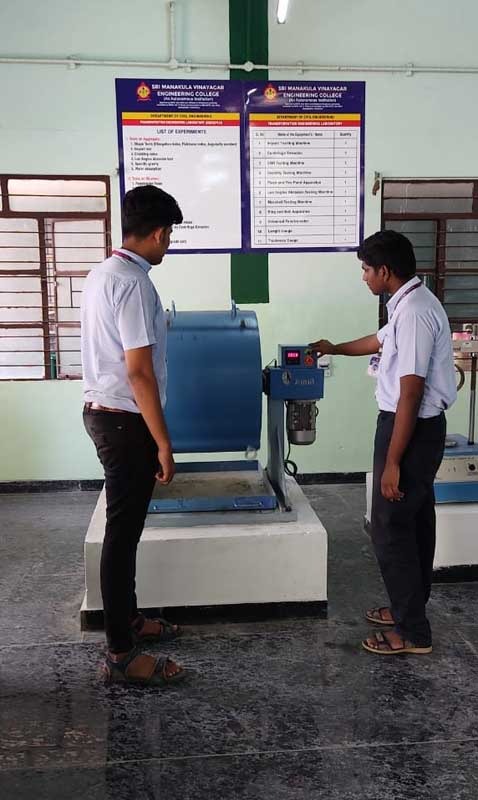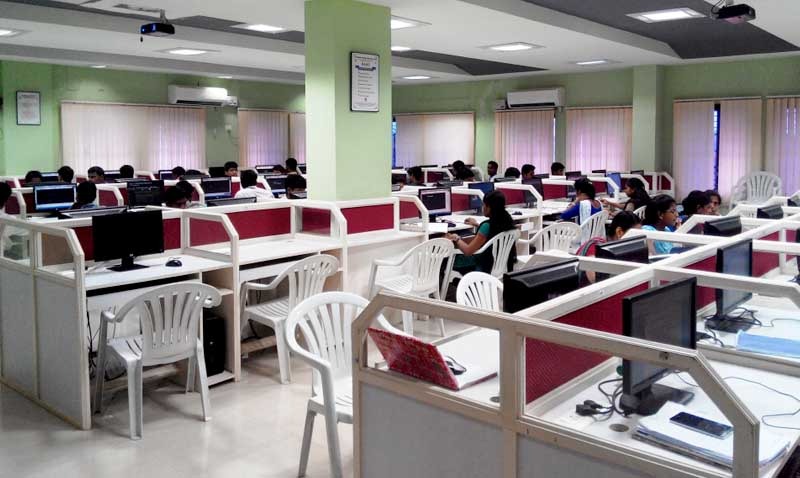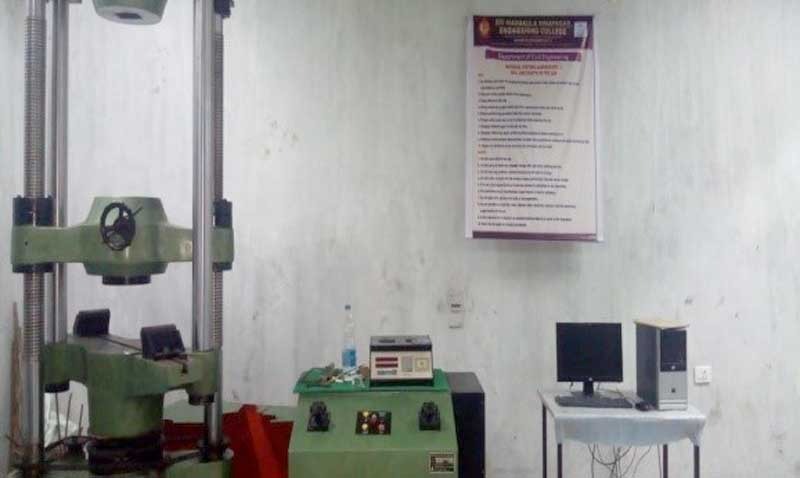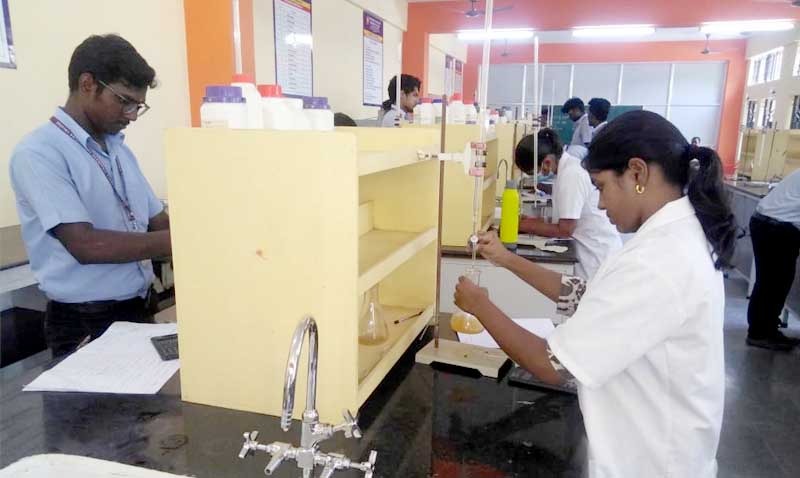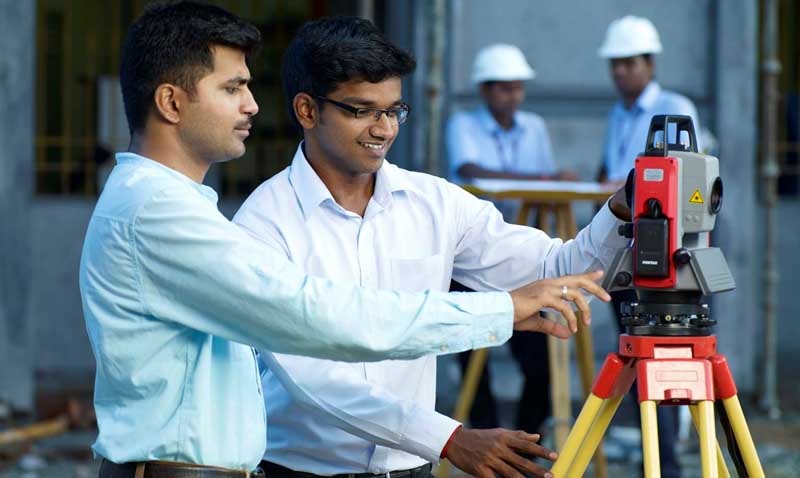- Civil Engineering Building Planning and Drafting
- Civil Engineering Practice Laboratory
- Fluid Mechanics and Machines Laboratory
- Strength of Materials Laboratory
- Surveying Laboratory
- Concrete Engineering Laboratory
- Geotechnical Engineering Laboratory
- Modeling and Analysis Laboratory
- Sensors Applications in Civil Engineering Laboratory
- REVIT Architecture
- Transportation Engineering Laboratory
- Environmental Engineering Laboratory
List of Laboratories
Civil Engineering Building Planning and Draftin
Course Objectives
- To develop in students, graphic skills for communication of concepts, ideas and design of engineering products.
- To learn the concepts of planning and orientations of building using Autocad software
- To draft the building layout with load bearing walls, sloping roofs and framed structures
- To draft the industrial building with trussed roof
- To study the perspective views of buildings
Course Outcomes
After completion of the course, the students will be able to
- Familiarize with the fundamentals and standards of engineering graphics
- Understand the basic principle of drafting the plan, elevation and sectional views of the building by Autocad software.
- Draw building layout with load bearing walls, sloping roofs and framed structures
- Draw the industrial building with trussed roof
- Understand the different views of buildings
List of Experiments
- Study of capabilities of software for Drafting and Modelling – Coordinate systems (absolute, relative, polar, etc.) – Creation of simple figures like polygon and general multi-line figures.
- Drawing of a Title Block with necessary text and projection symbol.
- Drawing of curves like parabola, spiral, involute using Bspline or cubic spline.
- Drawing of front view and top view of simple solids like prism, pyramid, cylinder, cone, etc., and Dimensioning.
- Principles of planning, orientation and complete joinery details (Panelled and Glazed Doors and Windows)
- Buildings with load bearing walls
- Buildings with sloping roof
- C.C. framed structures.
- Industrial buildings – North light roof structures
- Perspective views of Buildings
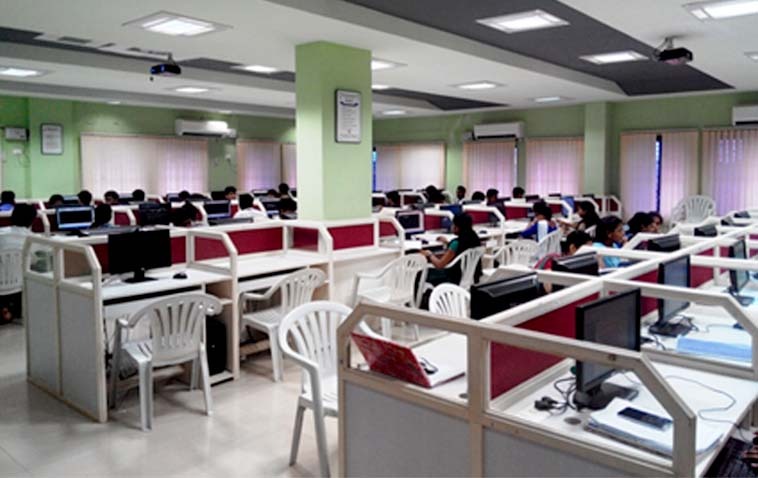
Civil Engineering Building Planning and Drafting
Civil Engineering Practice Laboratory
Course Objectives
- To get knowledge about several Workshop Practices like carpentry, fitting and welding.
- To give practice for masonry techniques and procedures.
- To learn the concepts of connecting the pipes for residential building.
- To study the types of building materials and their preliminary testing methods
- To gain the knowledge of IS Codes for testing the building materials
Course Outcomes
After completion of the course, the students will be able to
- Fabricate components with their own hands.
- Learn about tools and equipment, and measurements and drawings used by masons, and tasks like the spreading of mortar and bricklaying techniques.
- Learn about various Exposure regarding pipe connection.
- Get clear knowledge about Exposure to various testing for building materials.
- Familiarize with the IS codes for building materials.
List of experiments
Carpentry, Welding and Fitting Works
- Types of woods/timber, different types of tools, machines and accessories for wood works
- Types of welding, ARC welding, Gas welding, Gas Cutting, welding of dissimilar materials,
- Selection of welding rod material, welding processes.
- Fitting operation like chipping, filing, right angle, marking, drilling, tapping etc.
MASONRY
- Brick work, Different type of joints/bonds, Concept of line, plumb, right angle and water level.
PLUMBING
- Different types of pipes, joints, taps, fixtures and accessories used in plumbing.
- Components (pipes, bends, chambers etc.) used in sanitary/sewerage lines Scheme/plan for water supply and sanitary system for a simple residential building
Building Materials Laboratory
- Exposure to various building materials like sand, cement, bricks, wood, steel, plastics, aluminum etc and their preliminary testing methods
- Exposure to IS Codes for testing the above materials
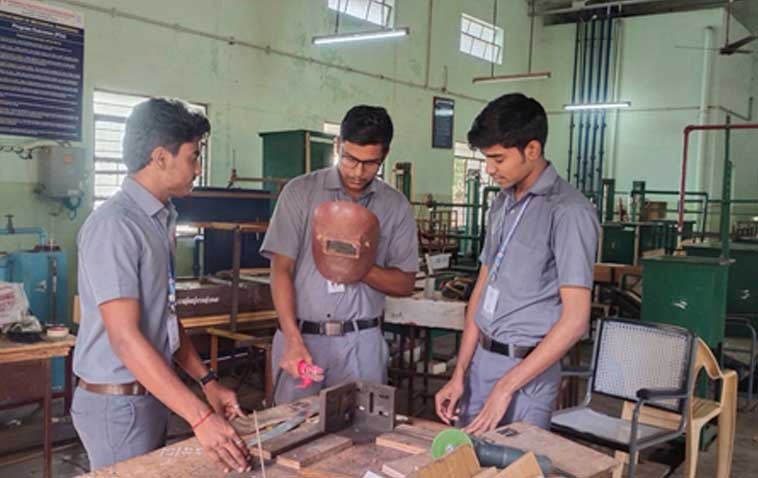
Civil Engineering Practice Laboratory
Fluid Mechanics and Machines Laboratory
Course Objectives
- To determine the discharge in pipes and open channels using various devices.
- To determine the Major and Minor losses experimentally in closed conduct.
- To determine the force on stationary vanes
- To study the performance and efficiency of pumps.
- To study the performance and efficiency of turbines.
Course Outcomes
After completion of the course, the students will be able to
- Students will be able to measure the discharge through the channels and pipes.
- Students will have a basic knowledge and able to calculate the different losses in pipes.
- Students will have confidence in calculating the forces on vanes.
- To estimate performance parameters of a given Centrifugal and Reciprocating pump.
- To select and analyze an appropriate turbine with reference to given situation in power plants.
List of experiments
A.Fluid Flow Laboratory
- Determination of co-efficient of discharge of venturimeter
- Determination of co-efficient of discharge of Orifice meter.
- Determination of co-efficient of discharge of Orifice.
- Determination of co-efficient of discharge of Notches.
- Determination of frictional losses in pipes.
- Determination of Minor losses in pipes
- Study of the impact of jet on vanes.
B. Fluid Machinery Laboratory
- Determination of co-efficient of discharge of venturimeter
- Determination of co-efficient of discharge of Orifice meter.
- Determination of co-efficient of discharge of Orifice.
- Determination of co-efficient of discharge of Notches.
- Determination of frictional losses in pipes.
- Determination of Minor losses in pipes
- Study of the impact of jet on vanes.
| Sl. No | Name of the Equipment | Quantity |
| 1 | Venturimeter apparatus | 1 |
| 2 | Orifice and mouthpiece apparatus | 1 |
| 3 | Orifice meter apparatus | 1 |
| 4 | Pipe friction apparatus (major loss ) | 1 |
| 5 | Losses in pipe line apparatus(minor loss) | 1 |
| 6 | Impact of jet apparatus | 1 |
| 7 | Centrifugal Pump | 1 |
| 8 | Reciprocating Pump | 1 |
| 9 | Jet – Pump | 1 |
| 10 | Submersible Pump | 1 |
| 11 | Parallel & Series Pump | 1 |
| 12 | Pelton Wheel Turbine | 1 |
| 13 | Francis Turbine | 1 |
| 14 | Kaplan Turbine | 1 |
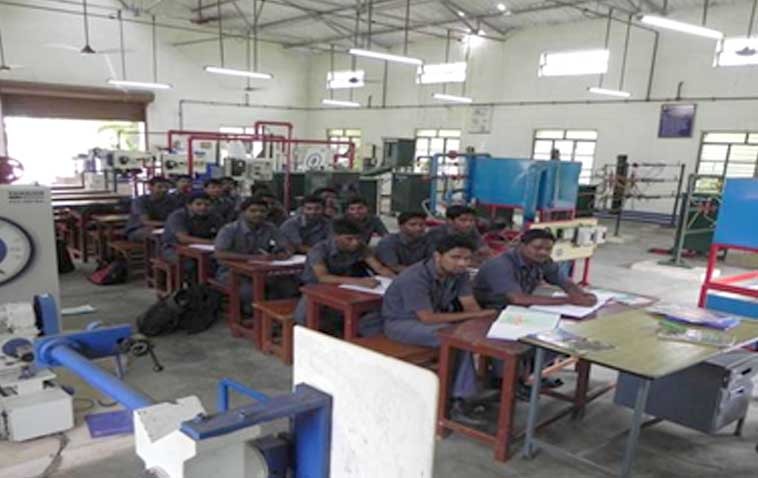
Civil Engineering Practice Laboratory
Strength of Materials Laboratory
Course Objectives
- To study the tensile and torsional property of steel bars.
- To determine the hardness of the given specimen
- To determine the ductility of the given material.
- To determine the compression property of wood and spring.
- To study the compression and water absorption property of a brick.
Course Outcomes
After completion of the course, the students will be able to
- Conduct tension and torsion test on steel and find out its properties.
- Find out hardness of material and use it to its efficiency.
- Find out the ductile properties of materials.
- Conduct compression tests on spring and wood
- Students will be able to use the suitable brick for the construction purposes based on their properties.
List of experiments
- Tension Test on Mild steel and Tor Steel rod specimens
- Direct Shear Test on Steel Rod Specimens
- Bend and Re-bend Test on Steel Rod Specimens
- Brinell Hardness Test on Metal Specimens
- Rockwell Hardness Test on Metal Specimens
- Impact Test on Metal Specimens using Izod arrangement
- Impact Test on Metal Specimens using Charpy arrangement
- Ductility Test on Sheet metals using Erichsen Cupping
- Torsion Test on Metal Specimens-
- Spring Test
- Compression Test on wood Specimens- Parallel and Perpendicular to the Grains.
- Compression Test on Brick and Water absorption test
| Sl. No | Name of the Equipment | Quantity |
| 1 | Universal testing machine | 1 |
| 2 | Brinell hardness testing machine | 1 |
| 3 | Rockwell hardness testing machine | 1 |
| 4 | Torsion testing machine | 1 |
| 5 | Izod & charpy apparatus | 1 |
| 6 | Deflection of beam apparatus | 1 |
| 7 | Spring testing machine | 1 |
| 8 | Erichsen sheet metal apparatus | 1 |
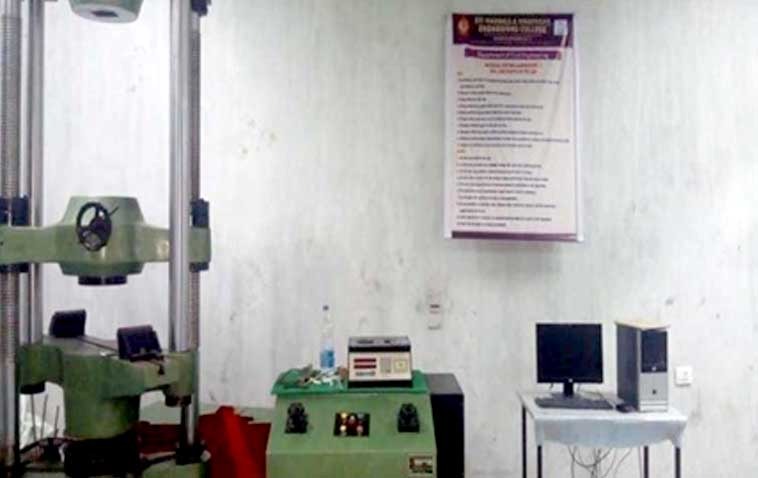
Strength of Materials Laboratory
Surveying Laboratory
Course Objectives
This course should enable the students to
- Train the students for using surveying instruments
- Make the students understand various problems in linear and angular measurement associated with field application
- Train the students to get clear idea about handling procedure of Theodolite, Tacheometry
- Make the students to determine the elevation of an objective by various means of surveying associated with vertical and horizontal control
- Provide adequate knowledge about Total station in order to get accurate measurement
Course Outcomes
At the end of Course students will be able to
- Acquire practical knowledge on handling basic survey instrument like chain, cross staff, ranging rods, ,
- Provide hands on exercise and make the students learn the concept of compass surveying.
- Provide knowledge to make the students learn the concept of leveling and development of contour map of given area.
- Students completing this course would have acquired practical knowledge on handling basic survey instruments including Theodolite, Tacheometry.
- Provide clear handling knowledge Total Station and GPS and have adequate knowledge to carryout Triangulation surveying including general field marking for various engineering projects and Location of site etc
List of experiments
Chain Survey
- Simple chain survey – calculation of area using cross staff
Compass Surveying
- Measurement of bearing of survey lines and arriving included angles by prismatic compass
Levelling
- Reduction of Levels:
(i) Height of Collimation
(ii) Rise and Fall method
- Fly levelling using Dumpy level
Theodolite – Study of Theodolite
- Measurements of horizontal angles by reiteration and repetition and vertical angles.
- Determination of elevation of an object using single plane method when base is accessible/inaccessible.
Tacheometry – Tangential System – Stadia System
- Determination of Tacheometric Constants
- Heights and distances by stadia Tacheometry
- Heights and distances by Tangential Tacheometry
Total station and GPS surveying.
- 10. Total Station Surveying – Measurements of Distances and angles, Slope distances, Height, Traversing, setting out, Area and Volume.
- GPS Surveying – Co-ordinate Measurements
| Sl. No | Name of the Equipment | Quantity |
| 1. | GPS | 2 |
| 2. | Total Station | 5 |
| 3. | Theodolite | 10 |
| 4. | Dumpy level | 10 |
| 5. | Auto Level | 03 |
| 6. | Prismatic compass | 10 |
| 7. | Survey compass | 02 |
| 8. | Subtense bar | 05 |
| 9. | Plane table | 12 |
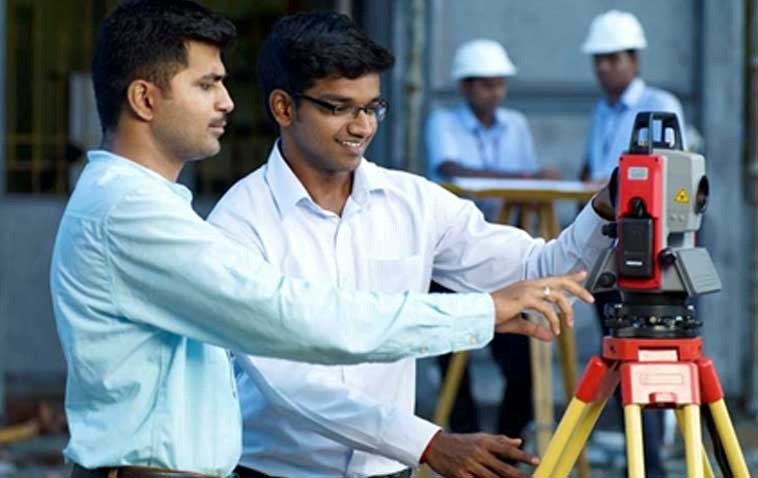
Surveying laboratory
Concrete Engineering Laboratory
Course Objectives
This course should enable the students to
- Study the basic concepts of testing on cement
- Learn the properties of fine aggregate and coarse aggregate
- Know the methodology of mix design.
- Study the various properties of workability of concrete and durability characteristics.
Study the various mechanical properties of concrete.
Course Outcomes
At the end of Course students will be able to
- Understand the properties of cement and its ingredients
- Know the properties of fine aggregate
- Understand the properties of coarse aggregates
- Carry out mix design for concrete
- Understand the various test on workability of concrete
List of experiments
- Tests on Cement,
- Specificgravity,
- Consistency,
- Setting Time,
- Tests on Fine Aggregate: Specific Gravity, Fineness Modulus and Bulking
- Coarse Aggregate: Specific Gravity, Fineness Modulus
- Mix Design
- Tests on fresh concrete: Slump Test, Vee Bee Consistometer, Flow Table, Compaction factor
- Mechanical Properties: Compressive, Split Tensile, Flexural Strength
| Sl. No | Name of the Equipment | Quantity |
| 1. | Vicat Apparatus | 5 |
| 2. | Le chatelier Mould | 3 |
| 3. | Le chatelier Flask | 5 |
| 4. | Lateral Extensometer | 1 |
| 5. | Digital Compression Testing Machine (2000kN) | 1 |
| 6. | Flexural Testing Machine | 1 |
| 7. | Split Tensile Set-up | 1 |
| 8. | Flow Table | 1 |
| 9. | Consistometer | 5 |
| 10. | Pycnometer | 5 |
| 11. | Sieve shaker motorized | 1 |
| 12. | Density basket | 2 |
| 13. | Crushing value Apparatus | 1 |
| 14. | Hot air oven | 1 |
| 15. | Slump test Apparatus | 1 |
| 16. | Compaction test Apparatus | 1 |
| 17. | Concrete Mixer (Drum Type) | 1 |
| 18. | Vibrating Table | 1 |
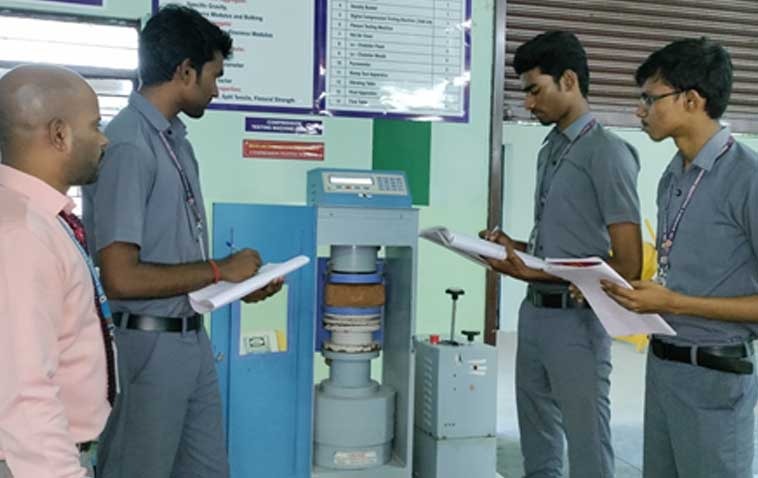
Concrete Engineering Laboratory
Geotechnical Engineering Laboratory
Course Objectives
This course should enable the students to
- Develop the skill for conducting experiment in different types of soil.
- Determine the index and engineering properties and to characterize the soil based on their properties.
- Determine the field density and compaction characteristic of the soil.
- Determine the shear strength parameters of the soil.
- Determine the penetration value N of the soil
Course Outcomes
After completion of the course, the students will be able to
- Classify the soil and assess the engineering Properties, based on index properties.
- Understand the concept of insuit density and compaction characteristic of soil sample.
- Understand about the techniques and method to determine the index properties and Engineering properties of soil sample. (K2)
- Understand about the techniques and method to determine the Engineering properties of soil sample
- Understand the concept and method to determine the penetration value N of the soil
List of experiments
Determination of Index Properties
- Determination of Grain size distribution (Sieve Analysis, Hydrometer Analysis)
- Determination of Specific gravity of soil grains (Pycnometer, Density bottle)
- Determination of Atterberg limits Test
-Liquid limit,
-Plastic limit
-shrinkage limit Test
- Determination of swell index Test
Determination of Insitu Density and Compaction Characteristics
- Determination of Field density test (Core cutter and sand replacement methods)
- Determination of moisture – Density relationship using Standard Proctor Test
Determination of Engineering Properties
- Determination of Permeability (Constant Head, Falling Head methods)
- Determination of Direct shear test on Cohesion less soil
- Determination of Unconfined compression test on cohesive soil
- Determination of Triaxial compression test on cohesive soil
- Demonstration of one dimensional consolidation Test
- Demonstration of Standard Penetration Test (SPT)
| Sl No | Equipment | Quantity |
| 1 | Permeability Apparatus | 1 |
| 2 | Core Cutter | 1 |
| 3 | Direct Shear Apparatus | 1 |
| 4 | Liquid Limit Apparatus | 1 |
| 5 | Permeability Apparatus | 1 |
| 6 | Plastic Limit Apparatus | 1 |
| 7 | Proctor Compaction Apparatus | 1 |
| 8 | Sand Replacement | 1 |
| 9 | Shrinkage Limit Apparatus | 1 |
| 10 | Standard Penetration | 1 |
| 11 | Triaxial Shear | 1 |
| 12 | Unconfined Compression | 1 |
| 13 | Weight Balance | 1 |
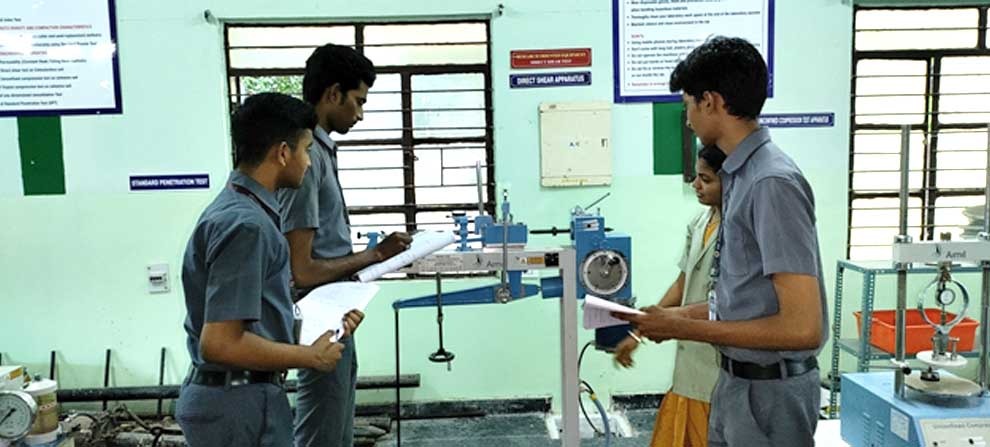
Geotechnical Engineering Laboratory
Modeling and Analysis Laboratory
Course Objectives
The course should enable the students to:
- Acquire basic understanding of Modeling and Analysis software
- Understand the different kinds of analysis and apply the basic principles
- Find out the stress and other related parameters of beams, frames with loading conditions
- Learn to apply the basic principles to carry out seismic analysis
- Know the natural frequency of different kind of beams
Course Outcomes
At the end of Course students will be able to
- Demonstrate the basic features of an analysis package
- Analyze the structure using E-TABS software
- Design the structure using E-TABS software
- Performing analysis and interpretation of results for final design
- Students would have gained knowledge on the usage of the software
List of experiments
- Introduction to Structural Analysis and Design using ETABS
- Introduction to various commands of ETABS and their applications in detail.
- Analysis and Design of Trusses
- Analysis and Design of continuous beams with fixed at both ends
- Analysis and Design of continuous beams with simply supported at both ends
- Analysis and Design of Plane Frames
- Modeling Analysis and Design of G+1 Story building
- Modeling and Analysis of G+5 Story building
- Analysis and Design of 2D Reinforced Concrete Frame
- Seismic Analysis and Design of 10 Story RC building
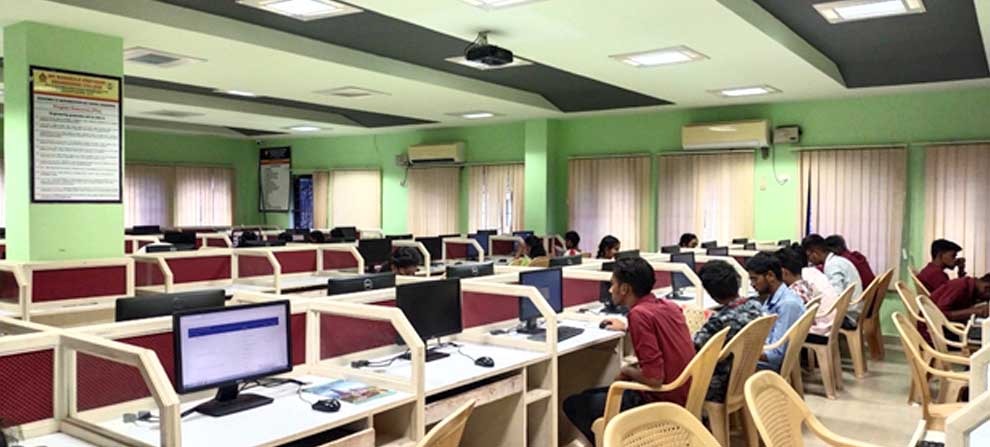
Modeling and Analysis Laboratory
Sensors Applications in Civil Engineering Laboratory
Course Objectives
This course should enable the students to
- Understand the different sensors
- Calibration of sensor
- Measurement of signal processing
Course Outcomes
After completion of the course, the students will be able to
- Identify the sensor
- Understand the errors in sensor
- Analyse the digital signal processing
List of experiments
- Instrumentation of typical civil engineering members/structures/structural elements
- Use of different sensors, strain gauges, inclinometers,
- Performance characteristics
- Errors during the measurement process
- Calibration of measuring sensors and instruments
- Measurement, noise and signal processing
- Analog Signal processing
- Digital Signal Processing
- Demonstration & use of sensor technologies
- A comprehensive study of data transmission in wireless sensor network.
Revit Architecture
Course Objectives
The course should enable the students to:
- Get exposed to the usage of software
- Learn the concepts of planning and orientations.
- Create a full 3D Elements like walls, doors, windows, components, floors, ceilings, roofs, stairs.
- Create a full 3D architecturalproject model
- Learn the concept of walkthrough in Revit Architecture
Course Outcomes
At the end of Course students will be able to
- Describe building information modeling methodology and its benefits.
- Use different parts of the Revit Architecture user interface and work with different types of architectural elements and families.
- Use the different views listed in the Project Browser, control the visibility and graphical
- Representation of objects in architecture model, and work with elevation, section, and 3D views.
- Set up a project and transfer standards between projects, add and modify levels in project model, create and modify grids.
List of experiments
- Introduction
- Core concepts
- Touring the Revit Workspace
- Starting a Project in Revit
- Levels, Grids, and Columns
- Using walls
- Doors and Windows
- How to use components
- Use of columns and their types
- Use of stairs and their types
- Railing in Revit
- Ramps
- Floors
- Roof
- Text
- Camera
- Walk through
- 3D modeling of Residential building
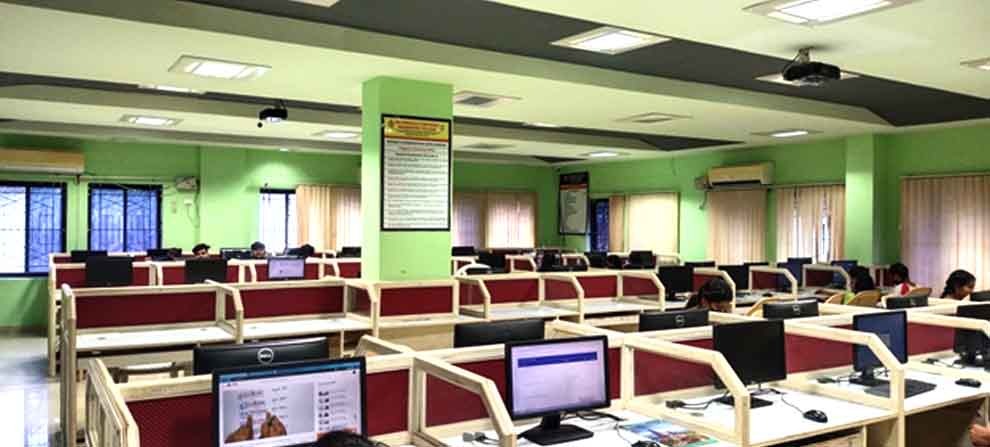
Revit Architecture
Transportation Engineering Laboratory
Course Objectives
This course should enable the students to
- Understand the procedures of testing of road aggregates
- Understand the procedures of testing of bitumen
- Understand the Marshall mix design
- Understand the procedures of testing of bituminous mix
- Familiar with test on subgrade soil
Course Outcomes
After completion of the course, the students will be able to
- Carry out the test on aggregate
- Conduct the test on bitumen
- Design the pavement
- Investigate the test on bituminous mix
- Carry out the test on subgrade soil
List of experiments
- Tests on Aggregate:
- Shape Tests (Elongation index, Flakiness index, Angularity number)
- Impact test
- Crushing value
- Los Angles Abrasion test
- Specific gravity
- Water absorption
- Tests on Bitumen:
- Penetration Value
- Ductility
- Softening point
- Flash & fire point
- Specific gravity
- Viscosity of cutback Bitumen
III. Tests on Bituminous Mix
- Marshall’s test on bituminous mixes
- Bitumen Extraction test by Centrifuge Extractor
- Test on Sub-grade soil
- C.B.R. Test – (on sub grade soil)
| Sl. No | Name of the Equipment | Quantity |
| 1. | California Bearing Ratio Test Apparatus | 1 |
| 2. | Los Angeles Abrasion Testing Machine with Abrasive Charge | 1 |
| 3. | Aggregate Impact test Apparatus | 1 |
| 4. | Universal Penetrometer | 1 |
| 5. | Ductility Testing Machine, Electrically Operated | 1 |
| 6. | Softening Point | 1 |
| 7. | Flash and Fire Point AIM – 509 Flash Point (Closed) | 1 |
| 8. | Standard Tar Viscometer | 1 |
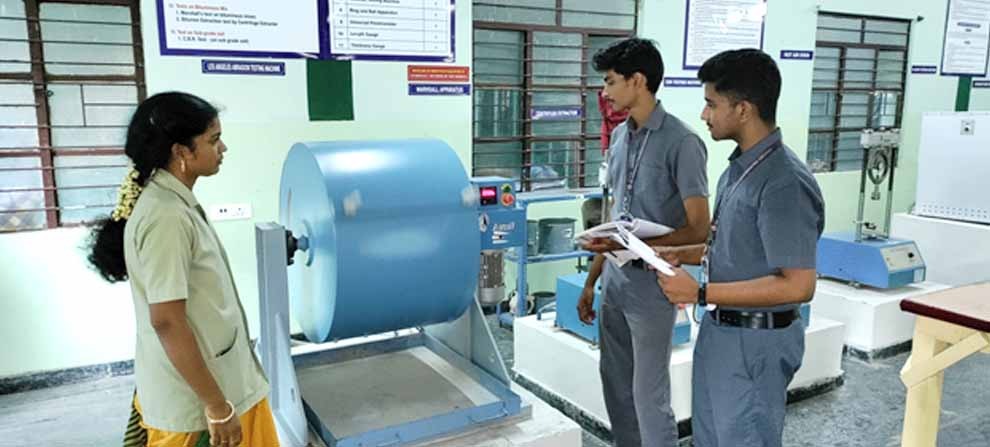
Transportation Engineering Laboratory
Environmental Engineering Laboratory
Course Objectives
This course should enable the students to
- Aware about water and its importance to human survival.
- Understand how to classify and analyze various quality parameters of raw water.
- Prepare water quality assessment report.
- Suggest required type of treatment to purify raw water.
- Analyze different quality requirements for industrial waters and domestic waters
Course Outcomes
After completion of the course, the students will be able to
- Discuss about importance of water and its quality analysis.
- Analyze various physico-chemical and biological parameters of water in case of quality requirements.
- Assess complete water quality assessment for EIA and domestic supplies.
- Suggest various types of treatment methods required to purify raw water with different contaminants.
- Apply the laboratorial results to problem identification, quantification, and basic environmental design and technical solutions.
List of experiments
Sampling and preservation methods and significance of characterization of water and wastewater.
| Sl. No | Name of the Equipment | Quantity |
| 1. | Turbidity meter | 1 |
| 2. | pH meter | 1 |
| 3. | Conductivity meter | 1 |
| 4. | Flame Photometer | 1 |
| 5. | Chlorine Comparator | 1 |
| 6. | Jar Test Apparatus | 1 |
| 7. | B.O.D incubator | 1 |
| 8. | C.O.D incubator | 1 |
| 9. | Muffle Furnace | 1 |
| 10. | Hot Air Oven | 1 |
| 11. | Magnetic Stirrer with hot plate | 1 |
| 12. | Water Bath | 1 |
| 13. | Heating Mantles | 2 |
| 14. | Colorimeter | 1 |
| 15. | Desicator 210mm | 5 |
| 16. | Crucibles 50ml | 10 |
| 17. | Burette with stand – B Class 100ml | 12 |
| 18. | Pipette with graduation 25ml | 12 |
| 19. | Beaker 100ml | 15 |
| 20. | Beaker 500 ml | 5 |
| 21. | Beaker 1000ml | 5 |
| 22. | Standard Flask 100ml | 10 |
| 23. | Standard Flask 250ml | 10 |
| 24. | Conical flask 250ml | 15 |
Physical Analysis
- Determination of Turbidity by using Nephlometer.
- Measurement of pH
- Measurement of Conductivity
- Measurement of Total Solids.
- Estimation of Suspended, volatile and fixed solids
Chemical Analysis
- Estimation of Alkalinity.
- Estimation of Chlorides.
- Estimation of Hardness.
- Estimation of Residual Chlorine
- Estimation of Dissolved Oxygen.
- Estimation of Manganese.
- Jar test for the determination of optimum coagulant Dose.
- COD test for water and waste water.
Biological Analysis
- BOD test for water and waste water
- Estimation of E-Coli.
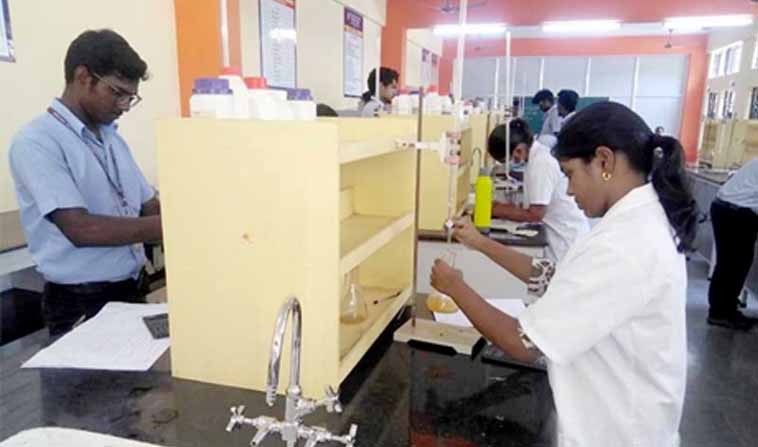
Environmental Engineering Laboratory
Photos

